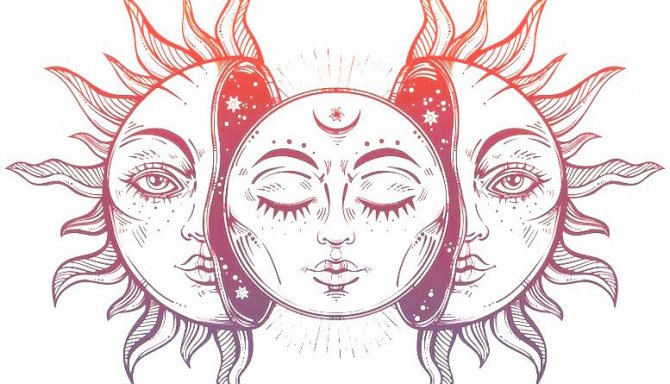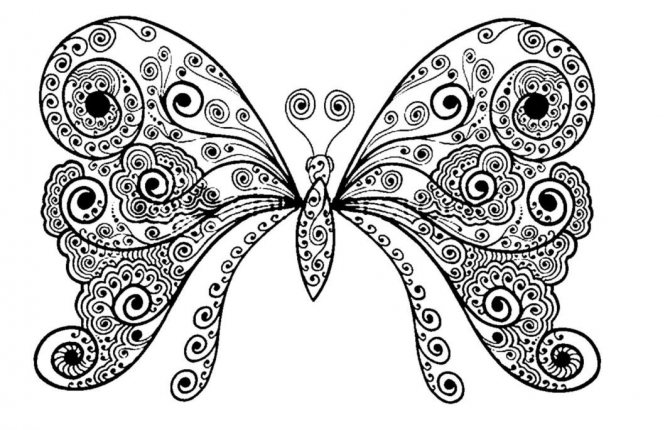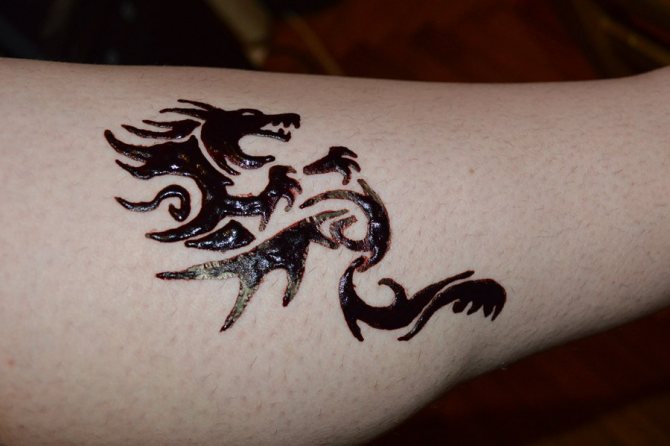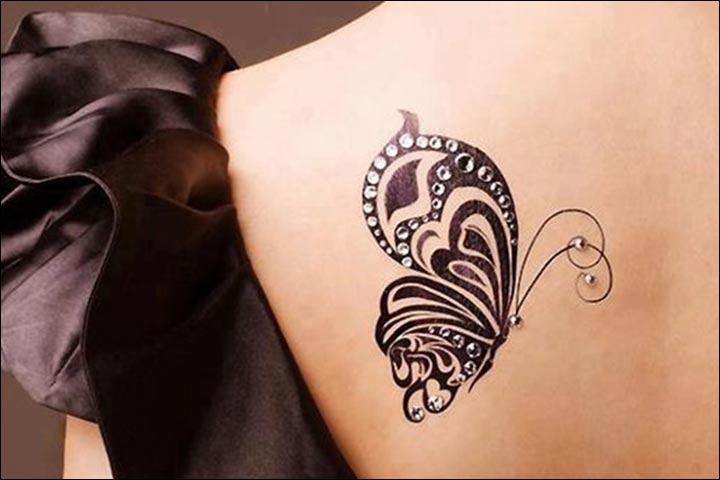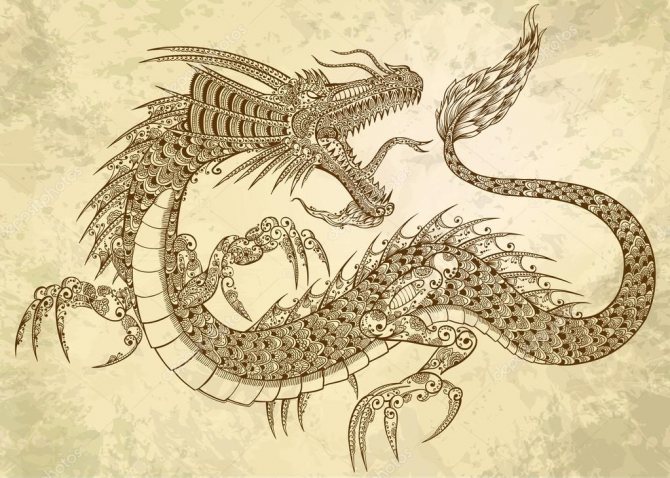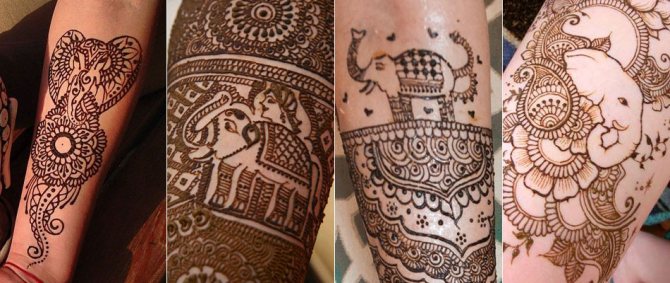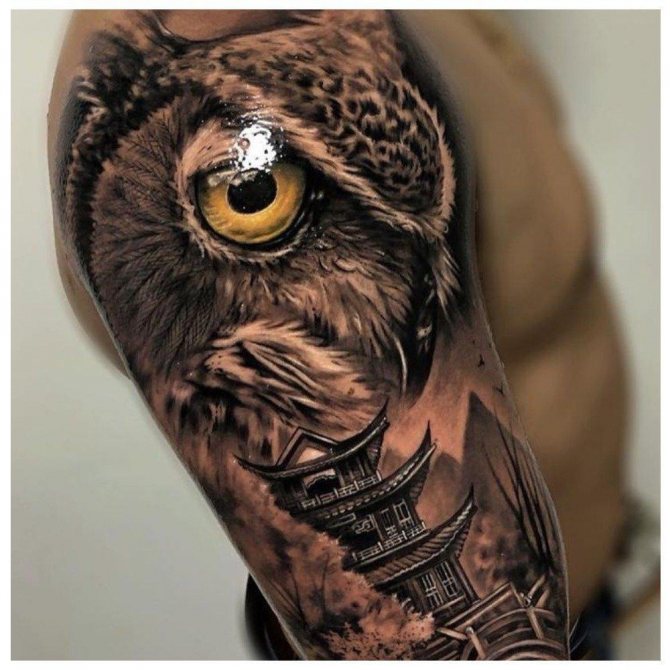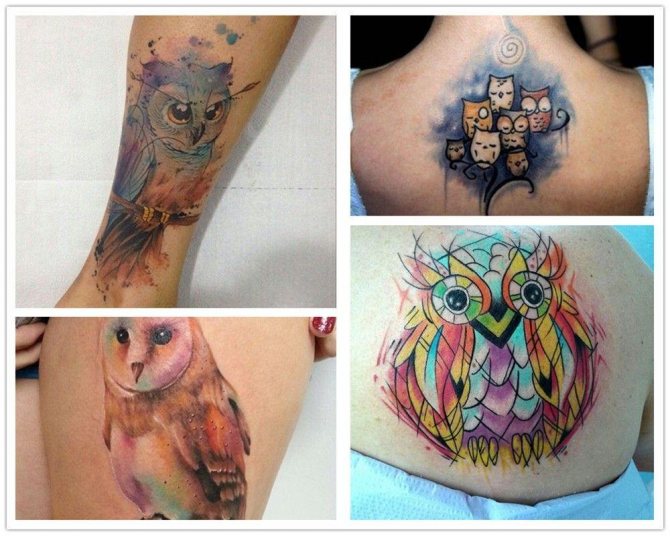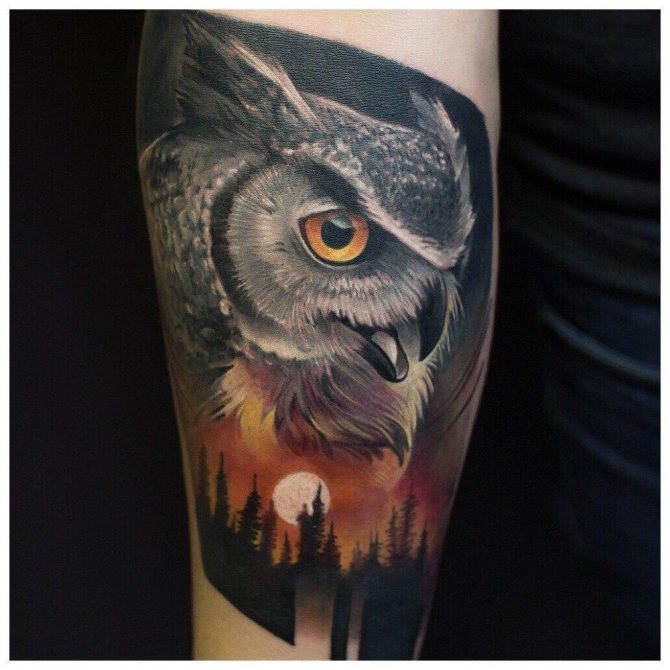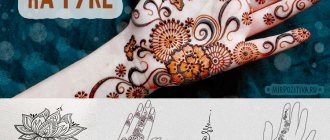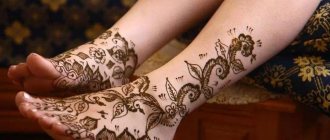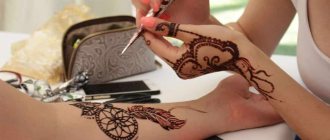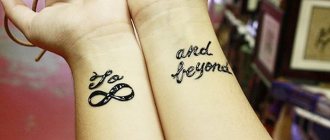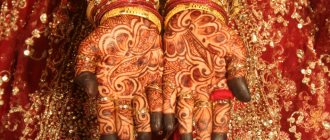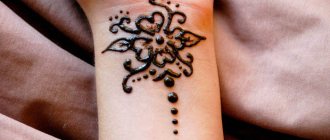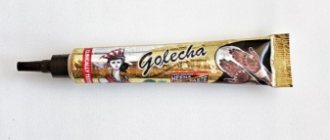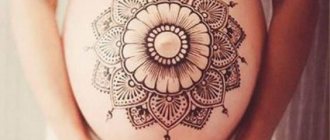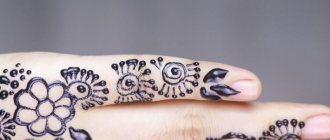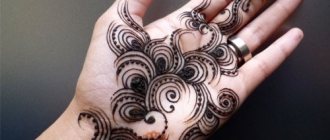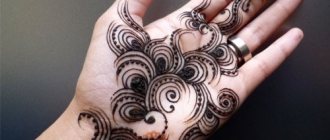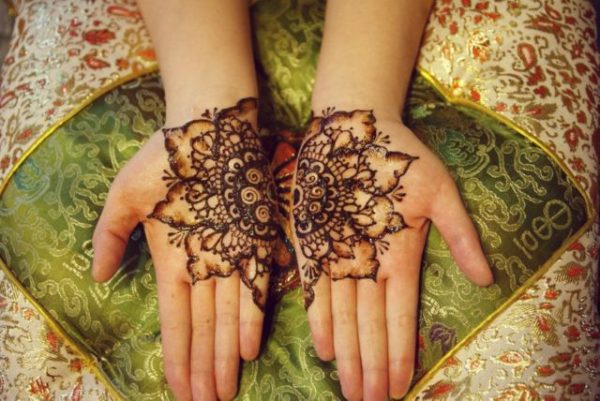
The desire to beautify your body is inherent in almost everyone, that's why mehendi on the arm is popular. And although this art deserves the respect of connoisseurs of beauty, not everyone knows what it represents. The fact is that mehendi appeared in Europe relatively recently, much earlier it became known in the Arab countries, and mehendi originated in India. And if the European people use the patterns on the body as decoration, in other countries each picture has a specific meaning.
In simple words, mehendi is painting on the body with henna, which is eventually washed off. Such decorations in Europe are called biotatu, that is, tattoos made of natural materials.
Meanings of common images with photos
Most often, fans of mehendi prefer to apply the following drawings on the hands:
- flowers - As is known, a flower symbolizes femininity, because his image prefers to apply the refined and romantic nature;
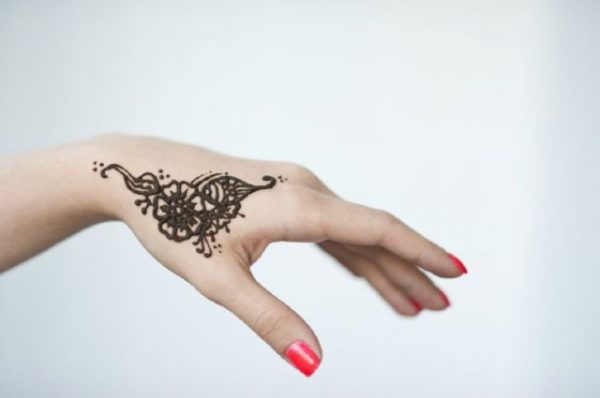

- Rose - This amazing and beautiful flower represents love, passion, luck;
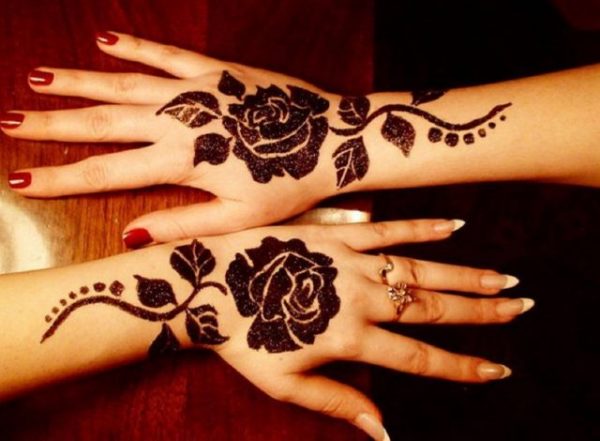

- owl - henna tattoo on the arm in the form of an owl symbolizes intelligence, power and wisdom;
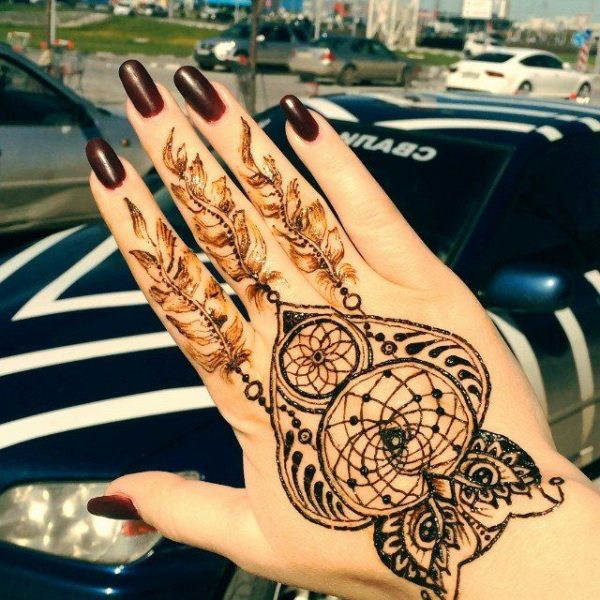

- butterfly - henna tattoo on the arm in the form of a butterfly brings good luck and health;
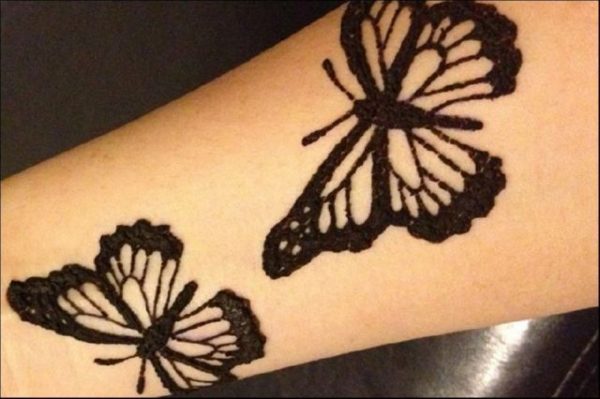

- Lotus - Some people think the lotus is a holy flower, mehendi drawing on the arm in the form of a lotus, brings good luck;
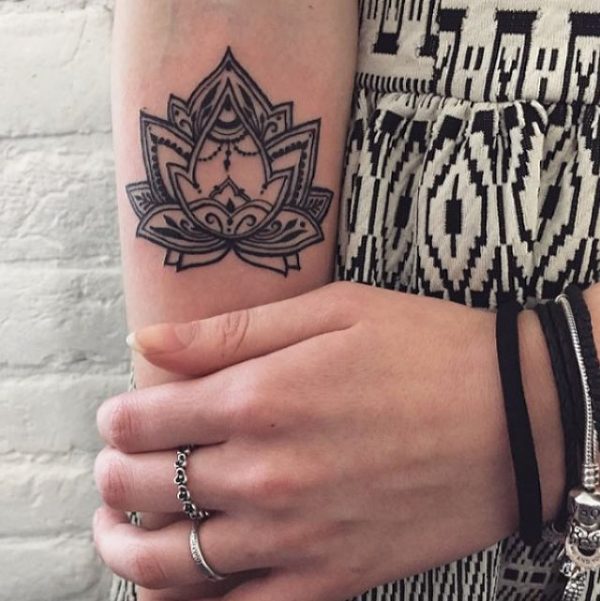

- feather - drawing in the form of a feather can have several meanings, if it is broken, it means the collapse of hopes, if directed upwards, it indicates the strength of will and spirituality;
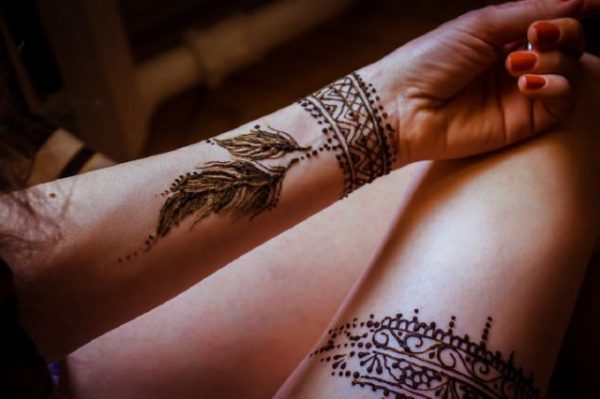

- dragon - is a symbol of power;
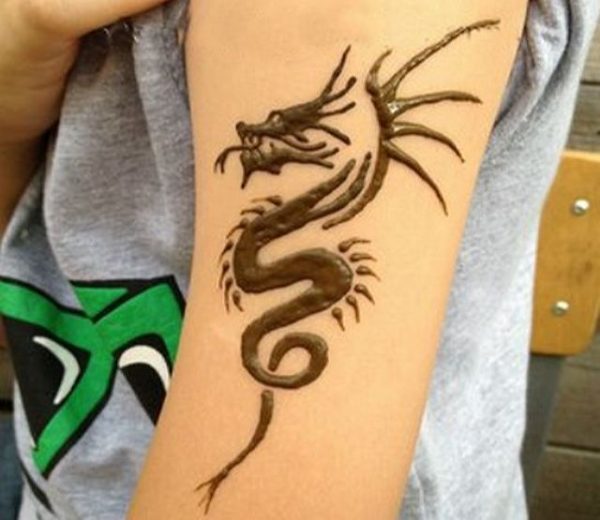

- cat - A tattoo in the form of a cat, which is applied to the hand, symbolizes cunning and playfulness;
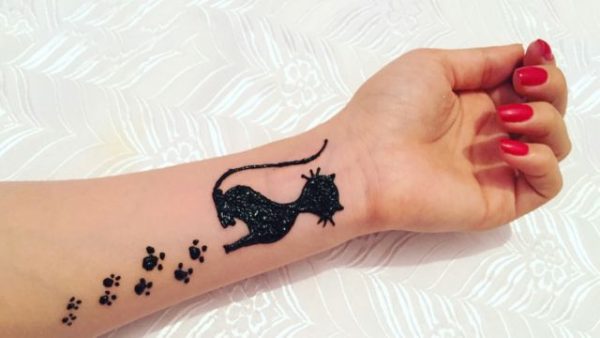

- "dream catcher" - provides a peaceful dream without nightmares, protects against bad thoughts and evil forces.
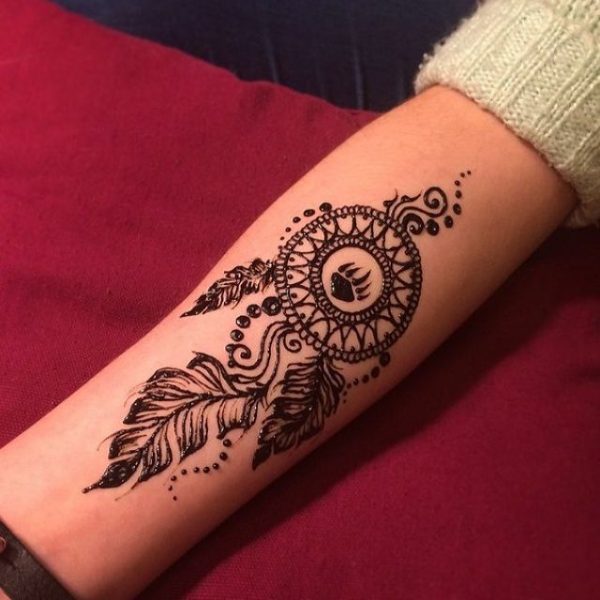

Familiarizing yourself with the photo of mehendi on the hand and the meaning of each of the drawings, you can easily choose the one that is most appropriate.
A word of caution! Usually women and men when applying temporary henna tattoos in mehendi style prefer an animal with which they identify themselves.
Mehendi stencils for men
Men are less likely to decorate their body with mendi. Their choices are various symbols of masculinity, strength, power, wisdom and intelligence. They prefer:
- trident - as a symbol of courage;
- The dragon for power, strength and perseverance;
- the snake - wisdom, prudence, the ability to wait;
- the sun - domination;
- the stars - protection from dark forces;
- six-pointed star - embodiment of harmony;
- The square - constancy and persistence.
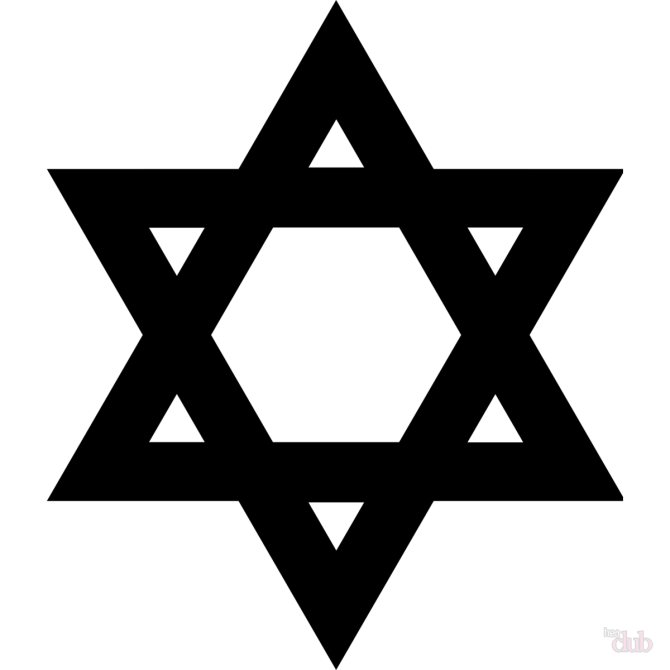

These are just some of the possible choices.
Sketches of mehendi on the hand
The advantage of patterns made with henna is that they can be drawn at home. It is not necessary to be an artist. For those who first practice applying mehendi on the hand, there are easy drawings for beginners. Such tattoos consist of literally a few lines. You can also use special stencils.
The photo shows easy sketches of mehendi on the hand for beginners.
And those who have already mastered the art of mehendi, can move on to more complex variants of the patterns. Their sketches are on the photo.
Where to buy and how much it costs
All components necessary for applying mehendi, you can buy in specialized shops, online - stores or in any outlets selling cosmetics.
The main attention should be paid to the main component - henna. It must be intended for mehendi. Be sure to check the expiration date of the product and make sure that the packaging was opaque and sealed.
Otherwise, the henna may lose its properties, which will affect the quality of the drawing.
Approximate price range for the necessary purchases:
- henna 100 - 300 rubles;
- ready paste 50 - 700 rubles;
- stencils 25 - 50 rubles;
- Brushes 50 - 150 rubles;
- Oil for fixing of drawing 100 - 150 rubles;
- Ready-made mehendi set 500 - 2000 rubles.
Prices depend on the amount of product and manufacturer.
Main recommendations
To get a high-quality henna drawing on the arm, before making mehendi you should read some recommendations:
- For beginners, it is better to choose henna in the form of a paste, and the tube must be firmly sealed and not deformed;
- If you decide to use henna powder, it is desirable to use a strong brew of black tea to dilute it;
- the addition of lemon juice in the dilution of henna color of the temporary tattoo is obtained more saturated and persistent;
- After mixing the henna should get a homogeneous mass, the presence of lumps is not allowed;
- if you add a few drops of essential oil in the paste of henna, the color of the image will be more saturated.
Preparing the place for the tattoo will also take a little time. First of all, it is necessary to remove hairs from the area of the body. The fact is that the paint penetrates into the hair follicle and is removed from there longer than from the skin. As a result, when the drawing is washed away, there will be traces in the form of dots for some time. Also, the treated area of the body should be pre-cleaned with a scrub to remove keratinized skin cells.
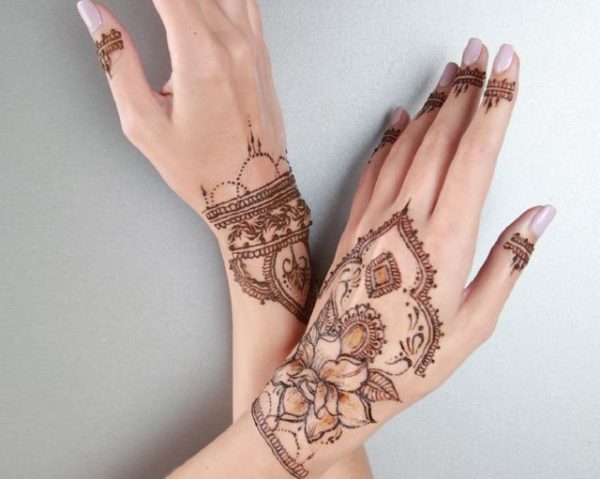

On a side note! When using ready-made paste for mehendi, it is enough to cut off a corner of the cone, and then you can start drawing. If you use henna in powder form, after diluting it, the resulting mass should be placed in a syringe without a needle or roll up a cone of thick paper. Specialists, as a rule, apply the pattern with a brush, stick or metal spatula.
A simple picture or a secret message?
A bird that loves the nightlife and scares with its glowing eyes is considered a rather strange creature. This beautiful but unusual animal has at all times caused negative attitudes among different nationalities. And not every modern person can safely survive a meeting with him. Especially in the dark.
Masters mehendi often draw the owl to their clients, as you can see in the photo with variants of works in the portfolio. The sketches are amazing. These are both colored drawings and black and white contrasts. Undoubtedly, the feathered creature attracts people by its mystery and beauty, but what do such tattoos mean? What symbolism lies in the simple patterns?
If we talk about the time period, for centuries and even millennia on different continents of the planet, this bird has caused terror and fear. Most of the inhabitants of the world, especially the Chinese, consider it a messenger of evil and misfortune. The bird leads a nocturnal lifestyle, so it has always been attributed an association with the dead, grief, mysticism, and black magic. In Asian countries, there is a belief that owls deprive their own mother's eyes with their beak. Therefore it is the embodiment of crime, evil in all its manifestations and destruction. Christian faith calls it a symbol of witchcraft, spiritual blindness, impurity and faithlessness.
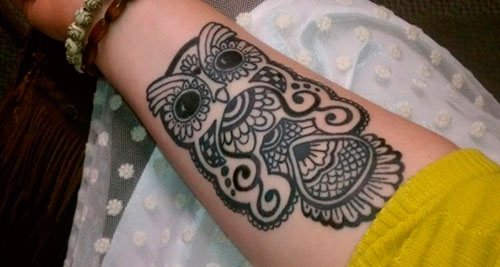

The night owl is also viewed negatively by African peoples. There is a legend that witches together with this strange inhabitant of the forest have fun and round dances near the graves of the dead. Indian sages believe that the raptor carries the dead to the afterlife. The Egyptians have about the same vision - it is a liaison between the living and the dead.
But there are some cultures where it is a sign of reliable protection, wisdom, and the image of a feathered creature is considered a powerful amulet against evil spirits and disasters.
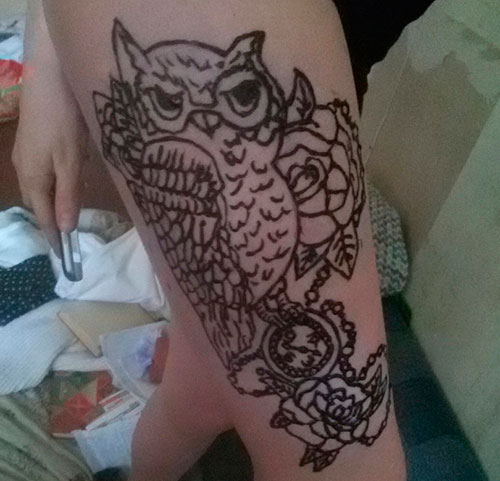

Indians especially venerate this sign. Hinduism attributes cosmic spirituality to the bird.
If we look into the pages of the history of the Roman Empire and Ancient Greece, an interesting fact opens up - the owl has always accompanied the great and beautiful goddess Athena - the patroness of learning, wisdom. If you look closely at the photos of ancient drawings, you can discern the image of a feathered creature on ancient coins. It is this country that is considered the progenitor of the phrase "wise owl," which is often used in writing fables and fairy tales. Over time, European countries have changed the attitude towards the raptor. The bird's mehendi and sketches no longer evoke fear and resentment. Even many official scientific institutions use the emblem with the nocturnal inhabitant of the forest perched on a stack of books.
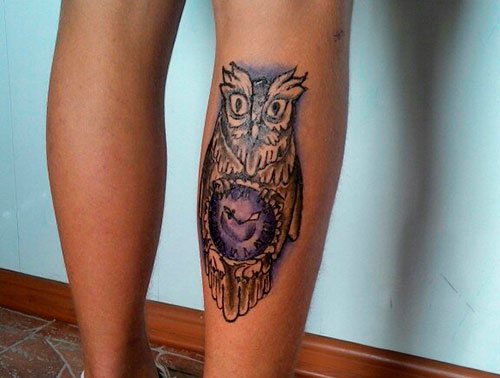

Today it is a sign of spirituality and intellectual perfection.
The modern meaning of the henna tattoo, which depicts an owl, has the following interpretations:
- thoughtfulness;
- intelligence;
- fear;
- asociality;
- wisdom;
- joy;
- loneliness;
- erudition;
- higher intelligence;
- sadness.
It is difficult to clearly define this symbol. There has been a dual attitude towards it since ancient times, so each person decides for himself what this kind of mehendi means to him. Important, not only the sign itself, but also the way it is depicted - the color, the expression of the eyes and eyebrows, the location of the wings and additional elements, religious attributes.
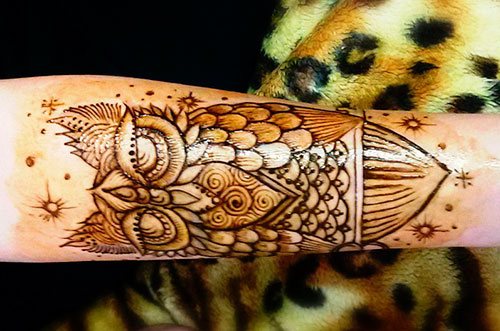

Now henna paintings with owls are more often chosen by people who like to lead a nocturnal lifestyle. They love the dark time of day and carefree pastime. In addition, the picture, according to most of its owners, protects from misfortune and trouble.
Mehendi areas on the arm
Hands and feet are the favorite parts of the body for girls to apply mehendi. There are a lot of pictures of henna paintings. As for the painting on the arm, there are several areas for a temporary tattoo
- on the back side - it is this area is almost always open to others, so to draw here patterns that carry a certain meaning, is very relevant;
- on the wrist - Most often on the graceful part of the limb prefer to draw small stars, hieroglyphs and hearts;
- on the shoulder - On mehendi in this area of the hand decide desperate girls who are not afraid to declare to the whole world their feelings and intentions, and they often choose "screaming" images or flirty patterns;
- on the forearm - It is considered that this is one of the most successful places for a tattoo, sometimes the image begins in this area and continues to the wrist, but most often girls are limited to small and neat pictures.
Certainly, it is possible to score a tattoo and on a palm, but it is more often practiced in east countries, and not in Europe.
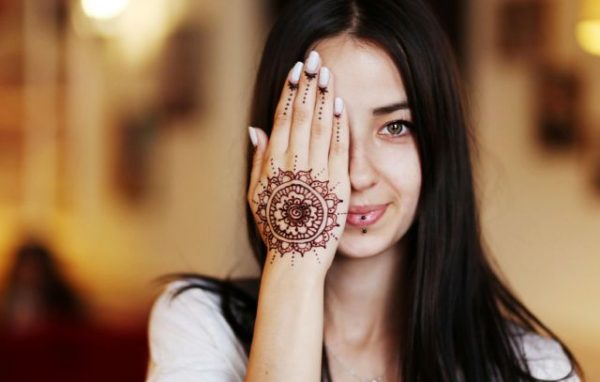

Experts recommend to beginners to make a sketch with a pen first, and only then to cover the contours with a mehendi mix.
Recipe for mehendi mixture
To prepare a mixture for a temporary tattoo, apply pure henna or combine it with bastma, which, depending on the proportions gives it a burgundy, brown or black color.
A side note! To get the black color, the ratio of bastma to henna is 3:1, brown - 2:1, bronze - 1:2.
Since for beginners it is difficult to determine what color the mixture has turned out, it is advisable to first try it out on a small area of the body, hidden from the eyes of others. In addition, depending on your skin tone, the same mixture may have a different effect on different people.
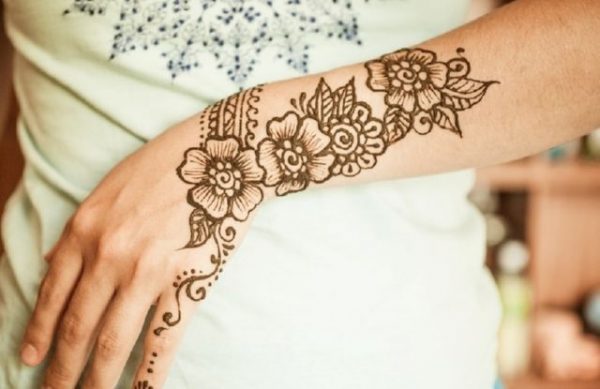

The mixture is diluted with warm water, and it must be added in small portions, stirring constantly. Stop stirring the mehendi tool when its consistency resembles a thick sour cream. It should be homogeneous, without lumps.
In addition, there are known recipes for diluting henna with tea, lemon juice, essential oil and sugar.
Mehendi application technique
After the mehendi mixture has been prepared, it can be used immediately. If recipes with tea brew are used, it is desirable to infuse it for three hours beforehand. Before the work is done, it is worth to make a sketch of the future drawing on paper or use a ready-made sketch.
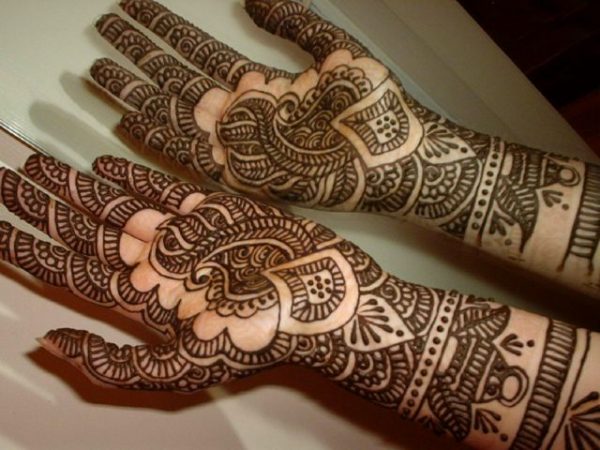

The treated area should be thoroughly washed with warm water and soap, and then additionally rubbed with alcohol, which will help degrease the skin. After that, you can proceed to the application of the pattern. The henna tattoo on the hand is drawn from top to bottom. This is necessary in order not to smudge the finished image.
After the application of henna on the hand it is worth to keep it until it dries completely. Depending on the pattern, it usually takes from half an hour to an hour. Then it is desirable to rinse the treated area slightly with cold water and blot with a towel.
To apply thin lines, the paste cone is cut off slightly to get a small hole. For beginners, experts recommend using disposable stencils. It is enough to attach them to the selected area and fill the holes with henna. Until the mixture completely dries, the stencils do not need to be removed.
READ OTHER INTERESTING ARTICLES ON THE SUBJECT
- Mehendi on the arm: easy drawings for beginners
- Copper hair color: 17 photos
- Granny square crochet: schemes with description
Mehendi care
The retention time of mehendi on the hand depends on the area of application and the individual characteristics of the body. For example, on the palms, which are constantly exposed to water and detergents, the pattern will not stay for a long time. On oily skin, it is less durable than on dry skin. Reduces the life of the henna tattoo, the constant use of scrub, greasy cream, sunbathing.
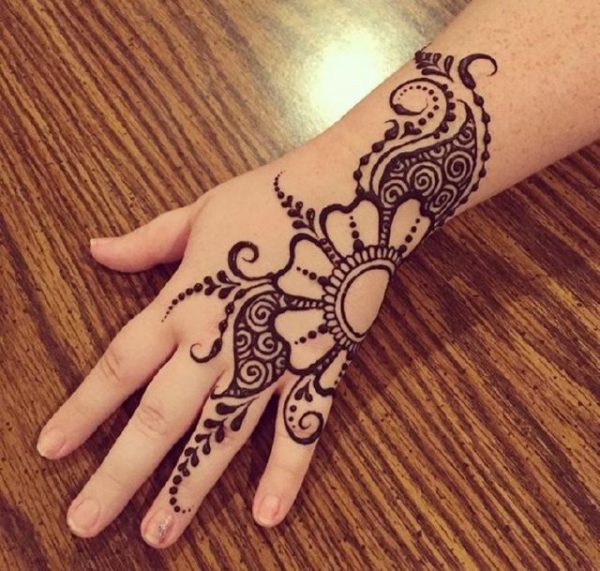

In addition, the proper care of the drawing is of great importance. After the henna dries completely and the treated area is washed with cold water, it is necessary to dry the skin and apply vegetable oil to it. It allows the pattern to better adhere to the body. It is also recommended to use protective equipment in the form of gloves when washing dishes. It is better to wash your hands with mild soap with a moisturizing effect, and when choosing creams to choose products that do not contain acids and bleaching components.
The meaning of the owl tattoo
In short, this symbol is quite controversial, it should not be perceived one-sidedly (exclusively positive or negative). In such a tattoo, you can see a lot of semantic shades:
- wisdom and death
- spirituality and witchcraft
- Joy and sorrow.
All depends on the perception. More often owl tattoo prefer people who love the night and the halo of mystery, not too sociable, but inclined to philosophical reflections and comprehension of wisdom.
How to wash off a temporary tattoo?
On average, mehendi stays on your hands for about a month and then completely disappears. If the drawing is not successful and you want to remove it in advance, the procedure will take at least a week.
To get rid of the painting on the hand henna, you need to apply a scrub twice a day on the drawing and thoroughly massage for a few minutes. Then rinse the product and apply a greasy cream to the treated area. It will also not be superfluous to use lemon juice, which has a whitening effect. To do this, you need to squeeze it from one fruit and thoroughly rub it into the drawing, and then leave it as a mask for 15 minutes.
These are affordable ways to get rid of mehendi, there is no special remedy.
What is it
Mehendi is body painting using henna. Unlike tattoos, these images are temporary decorations, but last much longer than regular paint (about three weeks). Drawings disappear from the body when the skin cells are completely renewed.
Because of this, henna body decoration is gaining wide popularity. It is possible to change the chosen ornamentation over time or to abandon it altogether.
Images can be in the form of familiar designs or unusual, ornate patterns. They have their own symbolism, are applied to different parts of the body and vary in size.
The choice of a mehendi theme and its location have a certain meaning. It may be timed to coincide with an event (like a wedding). Or Hindi can be about a certain character trait of its owner.
